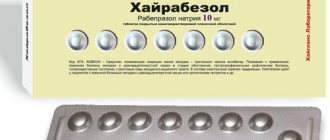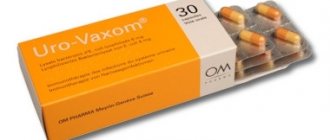Pharmacological properties of the drug Levitra™
A remedy for the treatment of erectile dysfunction. The physiological mechanism of penile erection is the relaxation of the smooth muscles of the corpus cavernosum and arterioles. During sexual stimulation, nitric oxide (NO) is released from the nerve endings of the corpus cavernosum, which activates the enzyme guanylate cyclase and increases the content of cyclic guanosine monophosphate (cGMP), resulting in relaxation of the smooth muscles of the cavernous body, causing an increase in blood flow to the penis. Vardenafil blocks specific phosphodiesterase type 5 (PDE-5), which causes the breakdown of cGMP. This enhances the action of endogenous NO in the corpus cavernosum during sexual arousal. Thus, when using Levitra, impaired erection is restored and a natural response to sexual stimulation is ensured. Vardenafil is rapidly absorbed after oral administration. Concentration in blood plasma after administration on an empty stomach reaches its maximum value within 30–120 minutes (on average after 60 minutes). Absolute bioavailability is about 15%. When taking vardenafil with fatty foods, its absorption rate decreases, the period to reach the maximum concentration increases to 60 minutes, the maximum concentration in the blood plasma decreases by an average of 20%; but there are no significant changes in AUC. When taking vardenafil with food containing no more than 30% fat, the pharmacokinetic parameters of the drug do not change. Vardenafil and its main metabolite are approximately 95% bound to plasma proteins, and this process is reversible and does not depend on the concentration of the drug. In the sperm of healthy men, no more than 0.00012% of the dose taken is determined 90 minutes after taking vardenafil. Vardenafil is metabolized primarily under the influence of the liver enzymes CYP 3A4 (main route), CYP 3A5 and CYP 2C9 (minor route). The total clearance of vardenafil is 56 l/h. After oral administration, vardenafil is excreted in the form of metabolites, mainly in feces (91–95% of the administered dose), and to a lesser extent in urine (2–6% of the dose). The half-life of vardenafil is on average 4-5 hours, the main metabolite M1 is about 4 hours. In healthy men aged 65 years and older, compared with younger patients (up to 45 years), an average increase in AUC of 52% was noted, but no significant decrease in the hepatic clearance of vardenafil was observed. The frequency of negative side effects of the drug does not depend on age. In individuals with mild, moderate and severe renal failure (creatinine clearance 55–80, 30–50 and ≤30 ml/min, respectively), the pharmacokinetics of vardenafil remain virtually unchanged. In patients with mild to moderate hepatic impairment, vardenafil clearance is reduced, and AUC and maximum concentrations increase in proportion to the degree of hepatic impairment.
What is erectile dysfunction, what causes it and how common is it?
Erectile dysfunction (ED) can be defined as the inability of a man to achieve or maintain an erection sufficient to insert the penis into the vagina and perform satisfactory sexual intercourse.
The incidence of ED varies depending on age. If in the age group from 20 to 40 years it averages 3%, then in the age group from 40 to 60 years it occurs in 15 - 20% of men. Over the age of 70, erectile dysfunction can affect up to 30% of men. At any age, ED is not the norm, because... the ability to have a regular and satisfactory sex life is one of the essential functions of a man of any age. Erection disorders can be caused by two groups of reasons: psychological (psychogenic) and somatic (organic). Research over the past 20 years has shown that ED is quite rarely caused by purely psychological reasons (stress, depression, behavioral characteristics, etc.). At the same time, it became known that about 80% of all cases of erectile dysfunction are caused by some physical (somatic, organic) conditions. These include: diabetes mellitus, high blood pressure, high blood cholesterol and vascular atherosclerosis, renal and liver failure, thyroid diseases, hormonal disorders, consequences of operations on the prostate gland and rectum, trauma and diseases of the spinal cord and brain (stroke , Alzheimer's disease, etc.), consequences of pelvic injuries, Peyronie's disease. Erection disorders can also be caused by taking certain medications. Persistent erectile dysfunction can develop due to bad habits such as drinking alcohol, smoking and taking drugs.
Use of Levitra™
Inside, regardless of food intake. The recommended starting dose is 10 mg. The tablet should be taken 15–25 minutes before the start of sexual intercourse, but can be taken 4–5 hours before. To achieve the desired effect when using Levitra, adequate sexual stimulation is necessary. Taking into account the effectiveness and tolerability of the drug, the dose can be increased to 20 mg or reduced to 5 mg. The maximum recommended dose of Levitra is 20 mg, the frequency of administration is no more than 1 time per day. There is no need to adjust the dosage regimen in the elderly, patients with renal failure or minor liver dysfunction. In patients with moderately severe liver dysfunction, the clearance of vardenafil is reduced, so the initial dose of the drug should not exceed 5 mg/day. Taking into account the effectiveness and tolerability in the future, the daily dose of Levitra can be increased to 10–20 mg.
Side effects of Levitra™
Usually well tolerated, side effects are transient and mild. The most common (10% of cases): headache, flushing (facial hyperemia); common (1–10%): dizziness, dyspeptic symptoms, nausea, nasal congestion; uncommon (0.1–1%): skin photosensitivity, hypertension (arterial hypertension), back pain, lacrimation; single (0.01–0.1%): arterial hypotension, myalgia, priapism. Isolated cases of anterior ischemic optic neuropathy have been reported (resulting in decreased vision up to permanent loss), which is believed to be associated with the use of PDE-5 inhibitors, to which Levitra belongs. Most of the examined patients were at vascular risk (severe optic nerve congestion, age 50 years or more, diabetes, hypertension (arterial hypertension), cardiovascular diseases, hyperlipidemia and smoking). However, it has not been established whether these isolated cases are directly attributable to the use of PDE5 inhibitors in patients at vascular risk or whether they should be attributed to other factors.
What place do erection pills occupy among ED treatment methods?
Currently, there are 5 groups of methods for treating erectile dysfunction:
- Psychotherapy and sex therapy, which is used only for so-called psychologically caused or psychogenic ED, less often as an auxiliary method for somatic or organic ED.
- Taking tablets or Viagra tablets for an erection: Cialis, Levitra. It is used as a first choice (first line of therapy) for all forms of organic ED, regardless of its cause.
- Injection pharmacotherapy or “erection on demand”. It is used as a second-line treatment for all forms of ED in cases where erection pills do not provide the desired effect or their use is contraindicated. Erection pills and injections of vasodilators into the penis can be used together as a combination treatment option for ED.
- Vacuum erection therapy or the use of vacuum erectors of various models and modifications to obtain or maintain an erection. It is a type of second-line treatment for organic and, less commonly, psychogenic forms of ED. — 90% efficiency; — There is no need to use medications that have side effects; — Non-aggressive method of treatment; - Helps create an erection while maintaining all precautions.
- Surgical methods of treatment: operations on the vessels of the penis and penile prosthesis. The first group of interventions is divided into operations on the veins (limiting venous outflow) and arteries (increasing arterial inflow) of the penis. Vein surgery can be used effectively in selected cases of ED, especially in combination with erection pills. Surgeries on arteries are ineffective and are used less and less. Penile prosthesis is the most effective and radical of all types of treatment for ED, the only method that provides a complete cure for organic ED. Surgical methods, as a rule, are used only in cases of organic ED when conservative therapy has failed.
So, erection pills are the first-line therapy, which most often begins in the treatment of any form of ED. Viagra, Cialis and Levitra are today the only tablet drugs available in the world that are truly effective in treating ED. The effectiveness of all other advertised tablets, as a rule, is invented (and absolutely not proven) by their manufacturers and is no different from a pacifier. All these domestic “impazs”, “golden skates”, foreign “veromaxes”, “superyochimbe extracts” and many others. other drugs are nothing more than means of making money based on people who trust primitive advertising.
How do erection pills work? How harmful are they? Is it possible to become addicted to erection pills? What are the side effects and contraindications? What are the known drug interactions?
Viagra, Cialis and Levitra have exactly the same mechanism of action and are selective (selective) inhibitors of the activity of the enzyme - phosphodiesterase type 5 (PDEס). This enzyme, in turn, inhibits the production of cyclic guanosine monophosphate (CGMP) in smooth muscle tissue, which is formed from guanosine monophosphate (GMP) under the influence of nitric oxide (NO). The main function of CGMP is to relax the smooth muscles of the cavernous (cavernous) bodies of the penis. When the action of PDE is inhibited, a significantly larger amount of CGMP accumulates in the corpora cavernosa, their smooth muscles relax much better and a significantly larger amount of blood rushes to the penis, which causes an erection.
Drugs in this group act selectively in the vascular tissue of the penis and are practically harmless. They do not cause lasting negative consequences with long-term and regular use. No addiction to erection pills develops. With the exception of purely psychological dependence. Having once tried an erection pill and felt its significantly better quality, feeling the lost voluptuousness, a man sometimes does not want to give up Viagra pills. This is similar to how a driver who has once driven a high-quality foreign car tends to never drive a Zhiguli again.
Special instructions for the use of Levitra™
Drugs for erectile dysfunction are prescribed with extreme caution in cases of anatomical deformation of the penis, such as angulation, cavernous fibrosis (Peyronie's disease), as well as in diseases that contribute to the development of priapism (sickle cell anemia, multiple myeloma, leukemia or leukemia). Due to the lack of information about the safety of Levitra in patients of these groups, taking the drug is not recommended for severe liver dysfunction, end-stage kidney disease (if hemodialysis is necessary), severe arterial hypotension (resting systolic blood pressure ≤90 mm Hg) , unstable angina, after a hemorrhagic stroke or myocardial infarction (within the last 6 months), as well as with hereditary degenerative diseases of the retina (retinitis pigmentosa). Since Levitra has not been used in patients with a tendency to bleeding or in patients with peptic ulcers of the stomach or duodenum, the drug can be prescribed in such cases only after careful comparison of the expected benefits and potential risks. Before using vardenafil, it is necessary to assess the condition of the patient's cardiovascular system, since sexual activity is associated with a certain cardiac risk. For patients with congenital prolonged Q - T taking class Ia (quinidine, procainamide) or class III antiarrhythmic drugs (amiodarone, sotalol), Levitra is contraindicated. For patients over 65 years of age, it is not recommended to exceed a dose of 5 mg due to decreased clearance of vardenafil. Levitra is not intended for use by newborns, children or women.
Levitra™ drug interactions
The safety and effectiveness of vardenafil in combination with other drugs to eliminate erectile dysfunction have not been established, therefore the use of such combinations is not recommended. A decrease in the clearance of vardenafil occurred with the simultaneous use of selective inhibitors of enzymes of the cytochrome P450 CYP 3A4 system (such as cimetidine, ketoconazole, itraconazole, indinavir, ritonavir, erythromycin). If combination with any of these drugs is necessary, the daily dose of Levitra should not exceed 5 mg. Concomitant use of vardenafil with α-adrenergic blockers may cause the development of symptomatic hypotension, so Levitra should be used no earlier than 6 hours after their administration. CYP 2C9 inhibitors (tolbutamide, warfarin), CYP 2D6 (selective serotonin reuptake inhibitors, tricyclic antidepressants), thiazides and thiazide-like diuretics, loop and potassium-sparing diuretics, ACE inhibitors, calcium antagonists, β-adrenergic blockers and inducers of CYP 450 metabolism (rifampicin , barbiturates) do not affect the pharmacokinetics of vardenafil. There were no signs of clinically significant interaction of vardenafil with tolbutamide (250 mg) or warfarin (40 mg), which are metabolized by CYP 2C9. A single dose of an antacid (magnesium/aluminum hydroxide) did not affect the bioavailability of vardenafil.
How and when are erection pills used and what is the difference between Viagra, Cialis and Levitra?
Erection pills from the group of PDE inhibitors (Viagra, Cialis, Levitra) are the first choice for any form of organic ED. They are prescribed immediately before sexual intercourse in a period of time from 30 minutes to 1 hour before planned sex. In some cases, drugs are prescribed regularly before each sexual intercourse, sometimes they are recommended to be taken only in cases where, in the opinion of the patient, there is the greatest chance of failure. These drugs have differences that are useful to know. Viagra has the greatest clinical experience, because. has been in use since 1998. This drug has already helped more than 16 million people worldwide and is the most well-studied of all erection pills. Viagra should be taken 1 hour before sexual intercourse, it works for up to 4 hours and is more likely to cause side effects after taking it compared to newer PDE inhibitors. Before taking Viagra, it is not recommended to eat rich fatty foods, because... it reduces the effectiveness of the drug. Levitra can be taken 15㪶 minutes before planned sex, its duration of action is slightly longer than that of Viagra, and the frequency of side effects is less. Cialis is taken 30 minutes before intended sexual intercourse; fatty foods do not affect its activity, and it lasts up to 36 hours and sometimes more. For this reason, Cialis is called a weekend pill, because... one tablet allows you to stay “in good shape” the whole weekend. To compare the side effect profile of all 3 drugs, you can refer again to Table 1.
What is the effectiveness of erection pills and is it possible to completely get rid of ED with their help?
The effectiveness of PDE inhibitors for various forms of ED ranges from 60 to 85%, according to various clinical studies. The tablets are designed to be taken before each sexual intercourse, i.e. when you take the pill, the erection improves; without the pill, the erection will be the same as it was recently before the start of treatment. In recent years, there have been reports that regular daily use of relatively small doses of erection pills for at least 12 weeks has a certain healing effect, i.e. improves the quality of your own natural erections. To enhance the effect of PDE inhibitors, they are used in conjunction with male sex hormones, injections of vasodilators into the penis, and operations to limit venous outflow from the penis.
What to do if erection pills don't work?
In such cases, under the supervision of a doctor, it makes sense to try second-line therapy or injections of vasodilators into the penis. If this does not help, you should resort to one of the surgical treatment options. It should be remembered that penile prosthesis has the highest effectiveness among all methods of treating ED.
The Andros clinic presents all modern methods of diagnosing and treating ED without exception. The most accurate diagnosis helps to individualize treatment and make it more effective. Mastery of the technique of implanting all types of penile prostheses allows us to achieve restoration of sexual activity even in the most seemingly hopeless cases. Contact only professionals armed with the entire arsenal of remedies and methods for treating erectile dysfunction available in the world!



